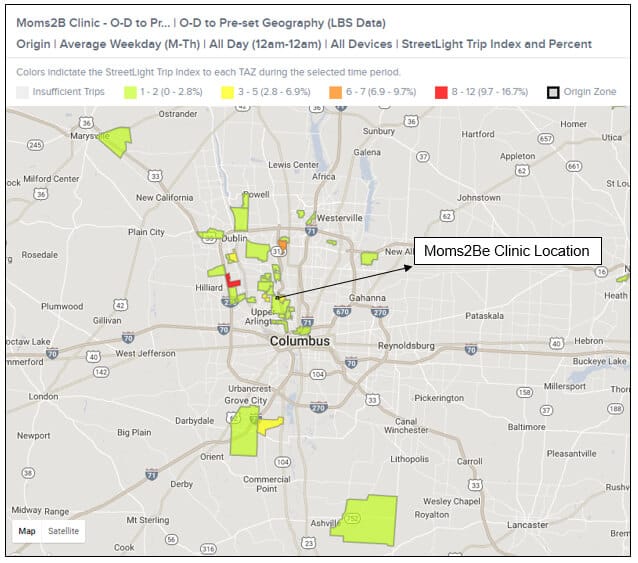
Can Big Data Use In Transportation Planning Reduce Infant Mortality Rates?

When most people think about transportation, they think about planes, trains, and automobiles – maybe even ferries. But infrastructure, technology, and our transportation networks do more than help us travel. They also have socioeconomic impacts. Getting from point A to point B efficiently is not only a matter of convenience. It can be a matter of life or death – and not just from a traffic safety perspective. The issue of infant mortality clearly illustrates the interplay of health, socioeconomic conditions, and transportation. In this article, I’ll explore this relationship and highlight a few ways that Big Data can be helpful for planners working to address infant mortality.
This article will focus on the City of Columbus, Ohio for two key reasons:
1. Infant Mortality is a Challenge That Must be Addressed in Columbus
Average infant mortality rates in the US are high compared to many developed countries, and Ohio is on the high end for the US. In 2016, Ohio had with 7.4 infant deaths per 1,000 live births. This is in contrast to the national average, which in 2016 was 5.9 deaths per 1,000 live births. While high infant mortality rates are a problem that we need to address nationwide, it’s particularly important to do so in Ohio.
Columbus, the most populated city in Ohio, struggles immensely with this problem. In their lower-income counties, like Franklin County, 2 to 3 babies die before the age of one every week, and 11.4 percent of babies in Columbus suffer preterm births. As is unfortunately the case in many localities, Columbus infant mortality challenges disproportionately affect lower-income areas and people of color. As I’ll explain below, a huge factor in this issue is transportation problems.
2. Columbus Has the Resources to Use Big Data to Address It
On the bright side, Ohio DOT already has a Regional Subscription to StreetLight InSight®, StreetLight Data’s online platform for turning Big Data into actionable transportation analytics – it’s more than traffic data alone. That means many planners in Ohio already have on-demand access to both Big Data resources and easy-to-use software. The StreetLight InSight software is key because it makes it easy for planners to transform messy, archival location data into the real-world information that can help address this challenge.
Columbus also received an amazing opportunity in 2016 when they won the Smart Cities Challenge sponsored by the federal Department of Transportation. The city received $50 million to create a new transportation system that would specifically address accessibility issues in low-income neighborhoods. With these funds, Columbus is working to use autonomous vehicles, connected cars, and updated bus fleets to better connect the city. A major goal of this plan is to link transportation in low-income neighborhoods to health care facilities.

How Transportation Impacts Infant Mortality Rates
According to an investigative article from City Lab, the ability to actually go to a doctors’ office is one of the biggest factors in infant mortality. For example, “There are more single mother households [in the South Linden neighborhood in Columbus] than in 99 percent of all U.S. neighborhoods, yet there are no OB-GYN clinics. With a median household income of about $21,000, relatively few households own cars.” Simply put, it’s hard for parents in South Linden to travel to be able to get to a doctor.
However, it could completely change the outcomes for infants if doctors were more convenient to South Linden. In Franklin County, where Linden is located, 14 percent of all infant deaths are due to prenatal conditions and congenital anomalies, which can go undetected if doctors’ appointments are missed. If a woman cannot physically get to the doctor, financially or due to a lack of transportation infrastructure, the odds of fixing the infant mortality get a lot longer. This is where using the right type of data for transportation planning can be a game changer.
Access to Big Data—and by Big Data, I mean the location data created by connected cars and trucks, smartphones, and wearables—can help communities use real-world information to design their transportation networks. Instead of relying on outdated information from surveys or incomplete data from sensors, planners can see the full picture of travel behavior for their entire city across all demographic groups. This drives more accurate travel demand models and forecasts, and it allows planners to easily and quickly measure the performance of policy and infrastructure investments. Columbus has an amazing opportunity to use Big Data and modern technology to get the information required to address important social issues.
Common applications on smartphones can aid in Columbus’ fight against infant mortality.
Why is Big Data the Right Type of Traffic Data to Address Infant Mortality?
It seems like the term Big Data is getting thrown around left and right to address huge problems in our communities. So, let me break it down into two digestible ways that Big Data can actually aid Columbus, and more generally Ohio, in their fight against infant mortality.
1. Understanding Real-World Travel Patterns
In 2016, 77% of people in the U.S. had a smartphone. Many smartphone users have applications—such as dating apps, weather tracking apps, shopping apps—that document their location through opt-in location-based services (LBS). This LBS data can be processed to reveal insights into travel patterns like trip origins and destinations, home and work locations, and more. This type of data allows planners to empirically understand where people are going and coming from. So how does this help infant mortality rates?
Well, planners could look at clinics such as Moms2B—a program dedicated to help mothers at high risk for infant mortality in Columbus—and assess what neighborhoods patients are actually coming from when they arrive to clinics, as well as what neighborhoods they are going to when they leave (see below). They could combine these real-world data analytics with other information sources. For example, they could talk to the clinic about the neighborhoods of their patients who miss the most appointments. From there, Columbus’ planners could target future transportation improvements or shuttle services to help mothers get to classes and appointments at this facility.
This heatmap shows the transportation analysis zones (TAZs) where trips to the Moms2B clinic location in Columbus, OH originate on average. The more red the TAZ is shaded, the more trips begin there. Note that, like most OB-GYN clinics in Columbus and elsewhere, Moms2B is located in a building that houses multiple medical service providers.
2. Increasing Civic Engagement
Big Data also allows for larger portions of a community to be civically engaged. Large scale transportation projects typically require public input, but the voices of those who are most affected by transportation problems or decisions, such as low-income individuals are often underrepresented in public meetings and conventional household surveys.
Traditionally, low-income individuals are less likely to attend public meetings due to a variety of reasons. These include not having a car to access the meeting, not being able to afford child care, having to work late and/or being unable to miss work. But many of these individuals have smartphones. This allows them to civically engaged when it comes to their transportation needs without having to actually go to a public meeting. In essence, the locational data their phones create can be their voice and communicate their transportation preferences and challenges, but only if planners use it.
If we put these two important benefits of Big Data together, then we can see how this new approach to traffic data could help Ohio and the city of Columbus to address infant mortality. By using Big Data, planners can understand what lower-income communities need in regard to transportation. They can utilize archival origin and destination matrices to recognize where people actually need to go, and then create shuttle services or bus lines that will have real benefits for lower-income communities. This means we stop putting bus lines in the places we think or assume should solve the problem. Instead, we start putting bus lines in the places where comprehensive, real-world data demonstrate that transportation accessibility improvements are truly needed the most.
According to CityLab, 23% of women who make prenatal appointments at free clinics do not actually show up. This relates to whether it is simple for them to get to their appointments. While the Smart City projects in Columbus don’t directly address infant mortality today, there is hope and potential that these women will benefit from spillover effects of transportation investments. But imagine if a planner decided to use Big Data to analyze where women who go to clinics are coming from, combined that information with the places women aren’t coming from, and then tailored transportation investments directly to their needs. Well, that would be a game changer.
Smartphones are altering our society in so many ways, so why not use all those billions of data points to create real, tangible benefits for these communities? Why not think beyond using traffic data for transportation alone, and focus on the ways that transportation can solve our greatest challenges? Women in Ohio and across the US need better access to health care destinations. Big Data can be the key to providing them with the transit options that will get them – and their families – to doctors conveniently, affordably, and efficiently.

